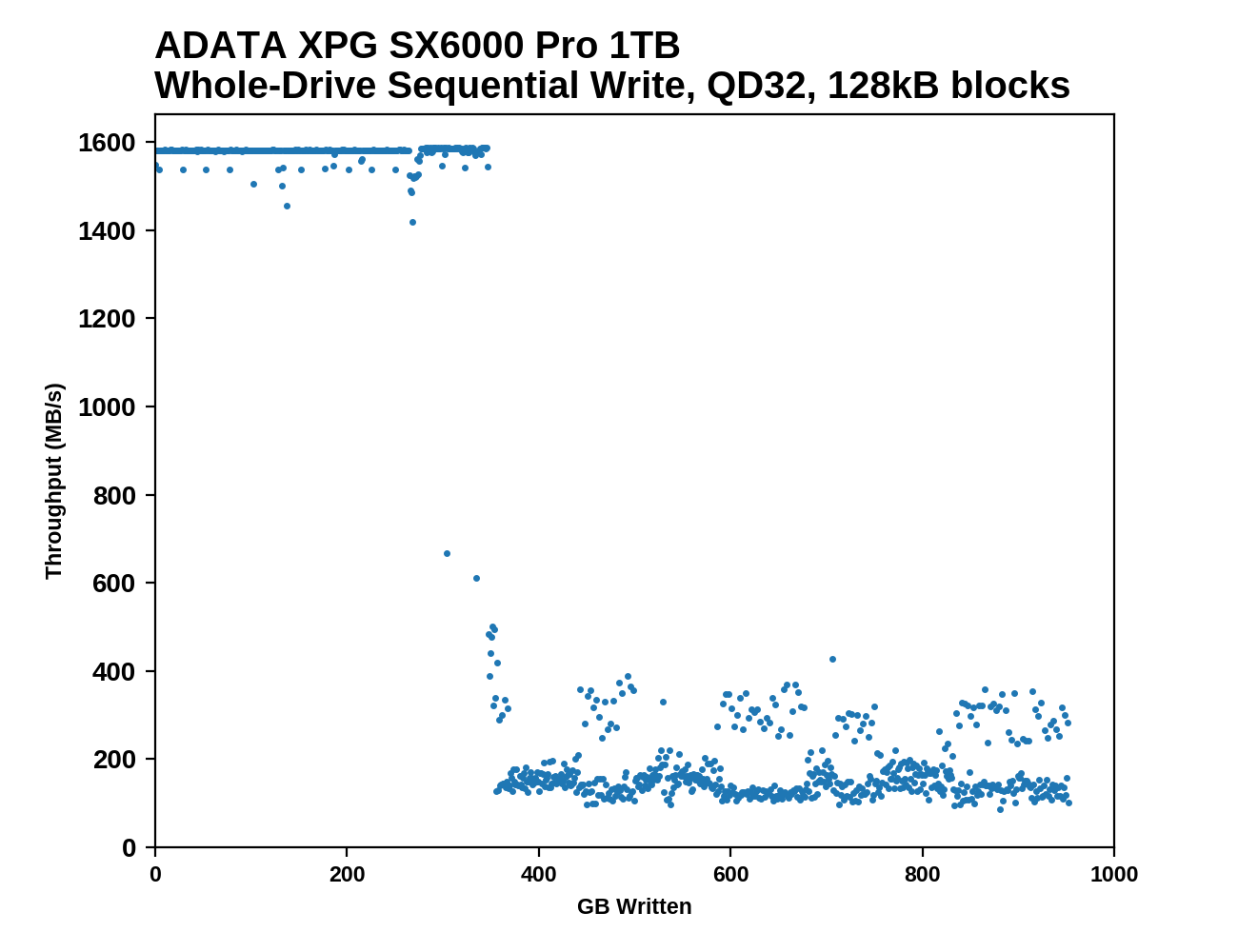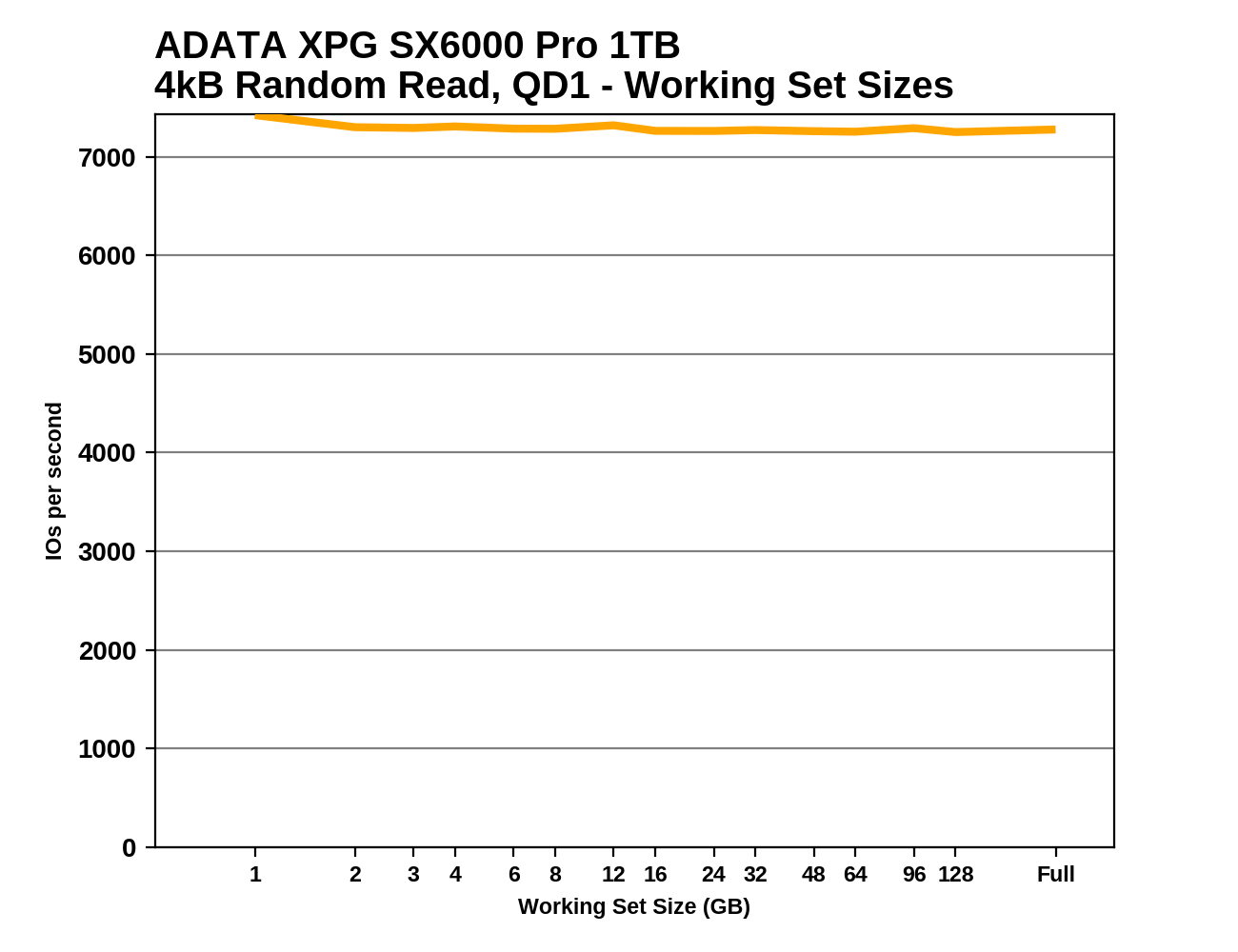The ADATA XPG SX6000 Pro 1TB SSD Review: Realtek's Entry-level NVMe Solution
by Billy Tallis on December 18, 2019 12:30 PM ESTWhole-Drive Fill
This test starts with a freshly-erased drive and fills it with 128kB sequential writes at queue depth 32, recording the write speed for each 1GB segment. This test is not representative of any ordinary client/consumer usage pattern, but it does allow us to observe transitions in the drive's behavior as it fills up. This can allow us to estimate the size of any SLC write cache, and get a sense for how much performance remains on the rare occasions where real-world usage keeps writing data after filling the cache.
 |
|||||||||
As with the Realtek-based ADATA SU750, the ADATA SX6000 Pro shows a large SLC cache and a sudden performance drop when it runs out. Since the SX6000 Pro's RTS5763DL controller is a 4-channel design compared to the 2-channel RTS5733, the post-SLC write speed is quite a bit faster than the SU750, but it's also less consistent. Aside from a few momentary drops during the SLC phase, the cache lasts for about 348GB of writes, which is pretty much the largest SLC cache size possible with 1TB of TLC NAND. The write speed to the SLC cache is just a hair faster than the advertised 1.5GB/s.
 |
|||||||||
| Average Throughput for last 16 GB | Overall Average Throughput | ||||||||
The post-SLC write speed from the SX6000 Pro is over twice as fast as the ADATA SU750 and is ahead of the Intel 660p, but is not up to the speed of the Mushkin Helix-L. And the Toshiba BG4 shows that DRAMless drives don't have to be anywhere near this slow; the BG4 is 3-4 times faster after its admittedly small SLC cache runs out.
Working Set Size
Most mainstream SSDs have enough DRAM to store the entire mapping table that translates logical block addresses into physical flash memory addresses. DRAMless drives only have small buffers to cache a portion of this mapping information. Some NVMe SSDs (the SX6000 Pro included) support the Host Memory Buffer feature and can borrow a piece of the host system's DRAM for this cache rather needing lots of on-controller memory.
When accessing a logical block whose mapping is not cached, the drive needs to read the mapping from the full table stored on the flash memory before it can read the user data stored at that logical block. This adds extra latency to read operations and in the worst case may double random read latency.
We can see the effects of the size of any mapping buffer by performing random reads from different sized portions of the drive. When performing random reads from a small slice of the drive, we expect the mappings to all fit in the cache, and when performing random reads from the entire drive, we expect mostly cache misses.
When performing this test on mainstream drives with a full-sized DRAM cache, we expect performance to be generally constant regardless of the working set size, or for performance to drop only slightly as the working set size increases.
 |
|||||||||
The ADATA SX6000 Pro shows very consistent QD1 random read performance regardless of the test's working set size, so it appears that it is not deriving any benefit from the NVMe Host Memory Buffer feature, unlike the Toshiba BG4. Nor do we see an obvious cache size effect from on-controller SRAM as with the WD Blue SN500. The SX6000 Pro is not alone in this; the Mushkin Helix-L with Silicon Motion's DRAMless NVMe controller also leaves us largely wondering how HMB earns its keep.










36 Comments
View All Comments
Billy Tallis - Wednesday, December 18, 2019 - link
My mindset is that your complaint isn't specific to the SX6000P; it's true of the entire category of "low-end NVMe" drives, so I don't want to single out the SX6000P for suffering from the same problem that all of its closest competitors also suffer from. It's halfway-decent at what it's trying to be, but it's trying to compete in a niche that barely exists in the first place.At least for the retail SSD market. The most popular retail NVMe SSDs are all high-end drives, so they get economies of scale that the low-end models don't, and that's why E12 and SM2262 drives can be priced so close to low-end NVMe. But in the OEM market, low-end NVMe drives do have a more compelling value proposition, and that's where the controller vendors make the real money.
That in turn influences what kind of drive designs the SSD vendors have on hand to readily convert into a retail product. The best example of this is the WD Blue SN500/SN550 series, which existed as an OEM product for a year before it came to retail. There's also Toshiba's BG series, which has been through four generations and they only bothered to do a retail release of one of them.
Great_Scott - Wednesday, December 18, 2019 - link
The SSD market is and has been monstrously compressed.The difference between performance tiers for SATA is frequently $10/tier. (excepting the occasional Samsung drive.)
I don't see that anything is substantially different for NVMe. This is a good, maybe great, budget drive. The problem being that you can spend $10 for a far better one.
At some point in the future where price isn't entirely dictated by Flash BoM this might change, but for now it only makes sense to get the best drive in a category since they all cost about the same.
Freeb!rd - Thursday, December 19, 2019 - link
My thoughts also... I was looking at NVMe Gen4x4 drives at around $200 for 1TB, but then saw the EVO 970 Plus was out performing them, almost bought that on Monday for $199, but saw a Sabrient Gen4 for $168 with $11 coupon on Amazon and went with that... NOW Amazon has the EVO 970 Plus for $169... which ever way the wind blows is the best value it seems. Although, Amazon has those "morphing" prices that seem to change often, probably based on your search habits. $169 for the EVO 970 Plus 1TB vs. $539 for the 2TB? Maybe Amazon tells vendors where the majority of sales volume is coming (ie 1TB) and competitors are getting more sales through via a certain price and miraculously the Samsung EVO price drops to match in a few days!! I'm sure Amazon analytics provided to their vendors play a part, probably be back to $239 after Xmas.Freeb!rd - Thursday, December 19, 2019 - link
FYI, so the Sabrient Gen4 was $157.xx after coupon, still a great deal on a Gen4x4 drive for my new X570 motherboard.HarryVoyager - Thursday, December 19, 2019 - link
The pricing is what makes all of this somewhat nuts. When I rebuilt my machine a month or so ago I ended up going with the 660p because I could get the 2TB version for around $170.While it isn't near the top of the heap for the destroyer, I don't do transfers of much more than a few GB at a time, and those are limited more by my Internet connection than by the drive.
I've also got a professional grade SATA SSD, and despite its synthetic benchmarks being an order of magnitude lower than the 660p, I honestly can't tell a difference between what's installed on which. And I'm a heavy gamer who runs stuff that is notorious for slow load times and heavy RAM usuage. Even there, I'm not usually pulling more that 20Gb of data in a set, so it's just not a big difference.
dragosmp - Thursday, December 19, 2019 - link
QLC was supposed to help with this segmentation. Hard to make a low end drive much cheaper just by not adding a 2$ DRAM chip and some PCB traces.Crucial P1 tends to kinda fulfill the QLC promise. It is sometimes at or around 80$ on offer for 1TB, has good warranty and performs quite well:
https://www.anandtech.com/bench/product/2533?vs=22...
tlmiller76 - Saturday, December 21, 2019 - link
I gotta disagree with the P1. I have one (1TB), and to be honest, I hate it. It's just...garbage in every way. I actually HAD an SX6000 Pro 1TB (unfortunately forgot to swap it out before I sold the laptop it was in) and it was so much better than the P1 they weren't even in the same zip code.zmatt - Saturday, December 21, 2019 - link
IMO low end NVMe drives aren't worth considering at all. If you dont have the money for a Samsung Evo then dont both because you aren't really seeing the benefits. Obviously this doesn't apply in the case of a laptop or SFF where you may not have a choice.TheUnhandledException - Wednesday, December 18, 2019 - link
It would be nice is low end NVMe drives were significantly cheaper but at least right now they are not. I don't really see the rationale for paying 2% less and getting 40% lower performance.sean8102 - Monday, February 3, 2020 - link
I upgraded from a 256GB SATA Samsung 840 Pro (my first SSD ever) to the HP EX 920 1TB and love it. Never thought I'd end up going with a HP SSD but their EX 9x0 product line is great. Thinking of getting another NVME drive just for games and going with the EX 950.